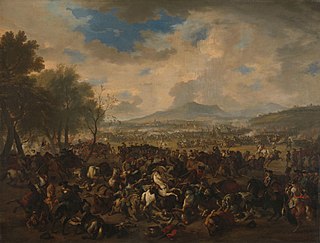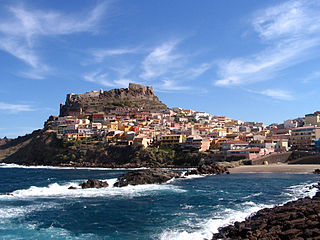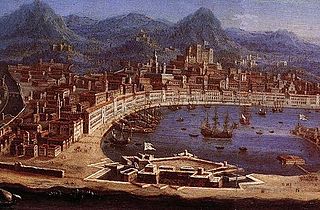
The Battle of Blenheim fought on 13 August [O.S. 2 August] 1704, was a major battle of the War of the Spanish Succession. The overwhelming Allied victory ensured the safety of Vienna from the Franco-Bavarian army, thus preventing the collapse of the reconstituted Grand Alliance.

The Battle of Ramillies, fought on 23 May 1706, was a battle of the War of the Spanish Succession. For the Grand Alliance – Austria, England, and the Dutch Republic – the battle had followed an indecisive campaign against the Bourbon armies of King Louis XIV of France in 1705. Although the Allies had captured Barcelona that year, they had been forced to abandon their campaign on the Moselle, had stalled in the Spanish Netherlands and suffered defeat in northern Italy. Yet despite his opponents' setbacks Louis XIV wanted peace, but on reasonable terms. Because of this, as well as to maintain their momentum, the French and their allies took the offensive in 1706.

Prince Eugene Francis of Savoy-Carignano, better known as Prince Eugene, was a distinguished field marshal in the Army of the Holy Roman Empire and of the Austrian Habsburg dynasty during the 17th and 18th centuries. Renowned as one of the greatest military commanders of his era, Prince Eugene also rose to the highest offices of state at the Imperial court in Vienna spending six decades in the service of three emperors.

Milazzo is a municipality in the Metropolitan City of Messina, Sicily, southern Italy; it is the largest commune in the Metropolitan City after Messina and Barcellona Pozzo di Gotto. The town has a population of around 31,500 inhabitants.

The War of the Quadruple Alliance was fought from 1718 to 1720 by Spain, and the Quadruple Alliance, a coalition between Britain, France, Austria, and the Dutch Republic. Caused by Spanish attempts to recover territories in Italy ceded in the 1713 Peace of Utrecht, most of the fighting took place in Sicily and Spain, with minor engagements in North America and Northern Europe. Spain also supported the Jacobite rising of 1719 in Scotland in an effort to divert British naval resources.

Count Claudius Florimund de Mercy was an Imperial field marshal, born at Longwy in Lorraine, now in France. His grandfather was the Bavarian field marshal Franz Freiherr von Mercy.

The Battle of Stromboli, also known as the Second Battle of Stromboli or the Battle of Alicudi, took place on 8 January, 1676, during the Franco-Dutch War. The battle occurred between a French fleet of 20 ships under Abraham Duquesne and a combined fleet of 19 allied ships under Lieutenant-Admiral-General Michiel de Ruyter. It lasted eight hours and ended inconclusively. The fleets fought again several months later at the Battle of Augusta in April.

The Battle of Cape Passaro, also known as Battle of Avola or Battle of Syracuse, was a major naval battle fought on 11 August 1718 between a fleet of the British Royal Navy under Admiral Sir George Byng and a fleet of the Spanish Navy under Rear-Admiral Antonio de Gaztañeta. It was fought off Cape Passaro, in the southern tip of the island of Sicily of which Spain had occupied. Spain and Britain were at peace, but Britain was already committed to supporting the ambitions of the Emperor Charles VI in southern Italy.

Francavilla di Sicilia is a town and comune in the Metropolitan City of Messina on the island of Sicily, southern Italy.

The 1720 Treaty of The Hague was signed on 17 February 1720 between Spain and the Quadruple Alliance, established by the 1718 Treaty of London. Its members included Britain, France, the Dutch Republic and Austria.

Don José Antonio de Gaztañeta e Iturribalzaga was a Spanish Navy officer. He was an innovator who applied a scientific approach to ship design. He was at the origin of the revival of the Spanish Navy in the eighteenth century. During the War of the Quadruple Alliance, he was the Vice-Admiral who commanded the Spanish Mediterranean fleet at the Battle of Cape Passaro against the British Royal Navy on 11 August 1718 off the coast of Sicily, where Gaztañeta's fleet was decisively defeated. This led to his most important contribution in the field of ship building, the renovation and re-organisation of the Spanish Navy following its poor performance in the war. Gaztañeta also participated in the Anglo-Spanish War of 1727 to 1729, where he successfully guided a Spanish fleet through the British blockade of Puerto Bello in Panama.
Jean François de Bette, 3rd Marquess of Lede was a Belgian military commander in Spanish service. He was also lord of the Fiefdom of Lede in Flanders.
The Battle of Milazzo was fought on 15 October 1718 near the city of Milazzo in Sicily, Italy between Spain and Austria as part of the War of the Quadruple Alliance.

James Francis Fitz-James Stuart, 2nd Duke of Berwick, 2nd Duke of Liria and Xérica was a Jacobite and Spanish nobleman.

The Kingdom of Sicily was ruled by the House of Savoy from 1713 until 1720, although they lost control of it in 1718 and did not relinquish their title to it until 1723. The only king of Sicily from the House of Savoy was Victor Amadeus II. Throughout this period Sicily remained a distinct realm in personal union with the other Savoyard states, but ultimately it secured for the House of Savoy a royal title and a future of expansion in Italy rather than in France. During this period, the Savoyard monarch used his new title to affirm his sovereign independence.

The Spanish conquest of Sardinia, also known as the Spanish expedition to Sardinia, took place between 22 August 1717 and 30 October 1717. It was the first military action between the Kingdom of Spain and the Holy Roman Empire after the War of the Spanish Succession (1701–1714), and was the direct cause of the War of the Quadruple Alliance (1718–1720). The Spanish troops commanded by the Marquis of Lede and Don José Carrillo de Albornoz, 1st Duke of Montemar, supported by the Spanish fleet, defeated the Emperor's troops easily, and conquered the entire island of Sardinia, which had been ruled by the Emperor since the Treaty of Rastatt (1714), returning it again and for the final time to Spain.

From 1700 to 1720, the Kingdom of Sardinia, as a part of the Spanish empire, was disputed between two dynasties, the Habsburgs and the Bourbons. With the death of Charles II, the last of the Spanish Habsburgs, on 1 November 1700, the throne passed to Duke Philip of Anjou, although the Emperor Leopold I also had a claim. Leopold was especially desirous of obtaining the Spanish inheritance in the Southern Netherlands and in Italy, which included Sardinia. With the failure of France to abide by the Second Partition Treaty, the other European powers lined up on the side of the Habsburgs. The Treaty of the Hague allotted to the Emperor the Spanish possessions in Italy. Imperial troops invaded Italy to seize them, and the War of the Spanish Succession began.

Frederick William I, Duke of Schleswig-Holstein-Sonderburg-Beck was a son of Duke August and his wife, Countess Hedwig Louise of Lippe-Alverdissen (1650-1731). He succeeded his father as Duke of Schleswig-Holstein-Sonderburg-Beck in 1689.

The Real Cittadella was a fort in Messina, Sicily. The Cittadella was built between 1680 and 1686 by the Spanish Empire, and it was considered to be one of the most important fortifications in the Mediterranean. Most of the fort was demolished in the 20th century, but some parts can still be seen.














